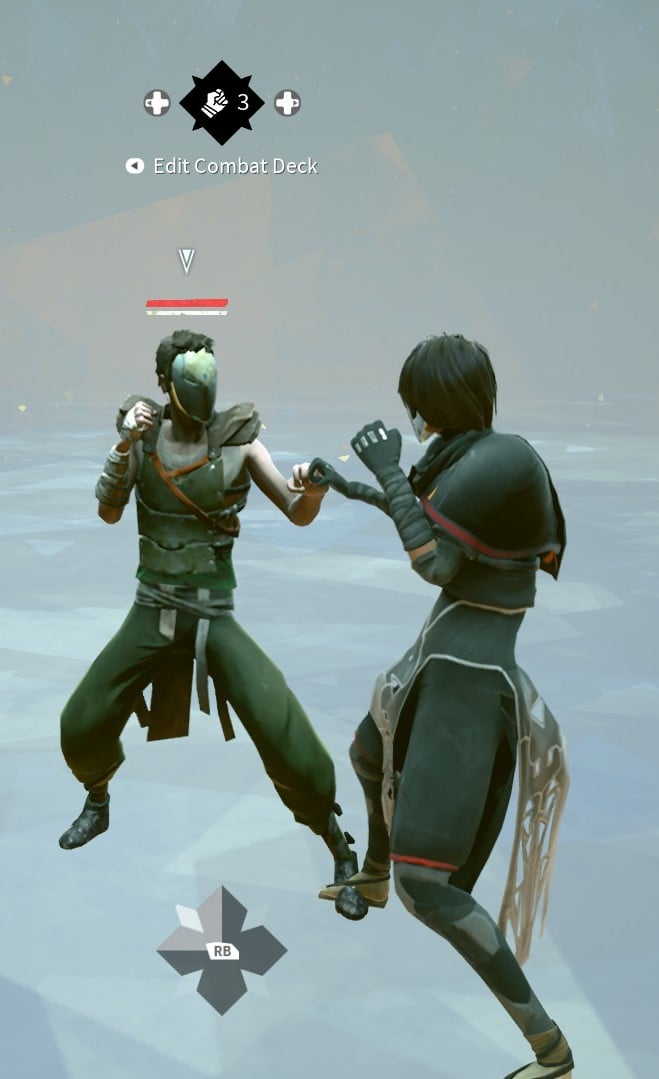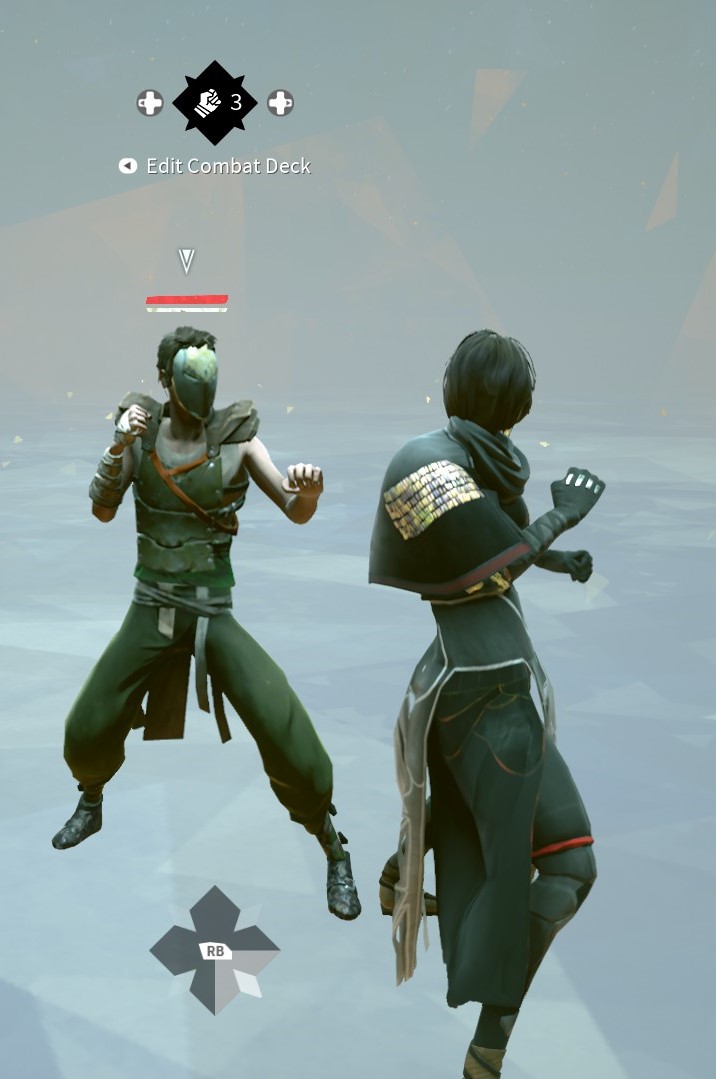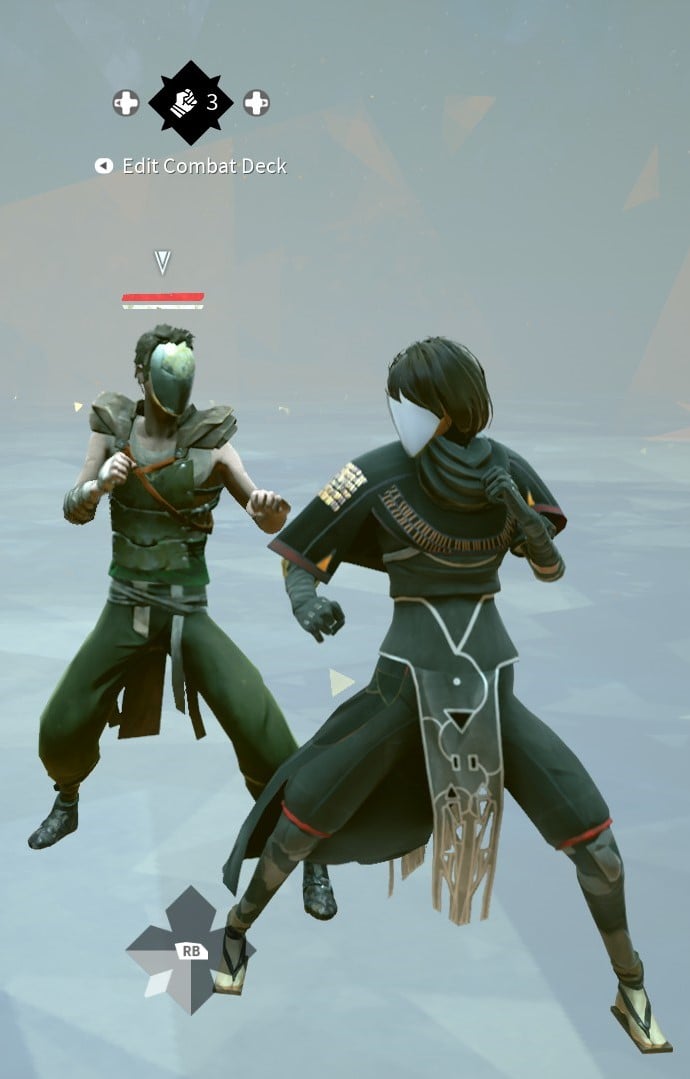Position yourself in one of four tactical stances during real-time battles and execute devastating attacks, dodges, and parries. Movement becomes your weapon as you engage in solo duels or intense three-on-three melees battles.
Players will define their character’s playstyle by picking a Fighting Style, a Weapon of choice, and arranging attacks in their combat deck to design their unique and personal attack flow.
The fight mechanics compliment the depth of the combat system. A perfect attack rewards precise timing by allowing following attacks to chain faster and stun longer. You can also use feints to cancel attacks. Tension Shards are glowing crystals which fill during combat and can be used to trigger powers which shift the advantage of a battle in your favor.
We highly recommend to visit the Classes, Attacks and Combat Deck pages in addition to this one, as they cover important mechanics of the game that complement the information of this entry.
Style
Players must equip a style at all times, this determines their base stats and grants them access to a defensive ability that can radically change how they play the game.
Stances
Players have four stances, which are essentially the player’s position relative to their opponent’s. Different moves are available from each stance, depending on the player’s Combat Deck. There is a stance indicator that is only visible when the player is locked on, and players can transition between stances manually or using attacks that change the current stance.
Walking speed while locked on is influenced by the current stance, while being in a forward pointing stance, walk speed is higher when moving towards the locked-on target and lower when moving away, and, on a similar fashion, while being in a backwards pointing stance moving away is faster than moving ahead.
 |
 |
 |
 |
| Top Right | Top Left | Bottom Right | Bottom Left |
Stamina and blocking
Characters need stamina to perform most actions; attacking, using style abilities, dodging and rushing. If the player's stamina is depleted by their usage of one of the previously mentioned actions, they won’t be able to perform any of them until they regain enough stamina to do so.
Stamina is additionally used to block attacks. Blocking an attack in absolver causes the player to take no damage from it (except when using weapons, more on that later), instead, the attacks deplete some of the player’s stamina. The amount of stamina damage caused by each attack varies greatly, with the fastest consuming more stamina for their user than the stamina they deplete on a blocking player, and the breaking attacks, or guard breaks, dealing more than half of the total stamina players usually have.
When a player blocks or takes an attack they are stunned for a brief moment, where no actions can be taken, this stun can however be cancelled into guard, making true combos impossible to get without guard breaking an opponent. When a player’s stamina is depleted by blocking an attack, they enter a special stun (broken guard) that cannot be canceled into blocking, this stun lasts for about 45 fames and allows the attacker to get several hits (depending on the speed of said attacks) of guaranteed damage, being the only way of executing true combos in game.
Stamina regens much slower when holding down the guard button. Releasing the guard in between each two blocked hits allows the stamina to regen faster, allowing the player to lose less stamina when guarding against several attacks. This practise is called Toggle blocking and can considerably boost the effectivity of defensive strategies when applied correctly.
Manual dodge
Dodge, or Manual dodge, as it is commonly called to differentiate it from Windfall’s skill avoid, allows the player to execute a defensive dash that has 2 invincibility frames (i-frames) close to the begin of the animation, though, when having host advantage, the invincibility period seems to be much longer than intended.
Dodging to the side is effective against thrusts and vertical attacks, and dodging backwards against moves with short range, long range horizontals are in general good counters to this, but it is also possible to i-frame through them.
Dodging costs a significant amount of stamina, and while being significantly easier to use than the style’s defensive abilities, grants very little reward. It is not recommended to rely on it for initiative reversal.
Powers and Tension Shards
Tension shards are gained when a player is hit and when they successfully avoid an attack using an avoiding attack, manual dodge or their defensive ability. Shard gain is influenced by the Will stat.
Shards can be used to cast Powers and summon Weapons.
Players start the game with two shards, and can unlock an additional three by leveling up, powers can be obtained by defeating marked ones and weapons by defeating bosses (for the first time), dropping them from rift disks and coins or buying them in the essence shop.
Rush
Players can rush while not locked on, this will consume stamina to make the player move faster. A rush attack can be used by inputting an attack button while rushing. If a rush attack connects, it stuns their target for a decent amount of time, allowing players to use it to catch up to fleeing opponents and, if the follow up is fast enough, lock them down for at least a couple of attacks. As rush attacks deal little damage, and are extremely predictable, it is not recommended to rely on them as primary engage options.
3d Movement - space out game
The movement in this game is fairly simple, with every option being fairly telegraphed. Interesting gameplay can however still be found in the space out game, as different attacks have different ranges and players can try to read which option their opponents will try, to then attempt to outpace it, or punish it with their defensive ability.
Once the close range engagement begins there is little to be concerned about space, however, some options like Shockwave, manual dodge, backpedaling (walking backwards on a back pointing stance while blocking) and unlock tech can create some space and re-enter the players into the space out game state. It is to be noted that backpedaling can be extremely effective against low range attacks (like the stagger special attacks), and, when combined with step cancellable moves (like Underknee Kick and Wallop Blow) , can make a defensive player very hard to approach.
Initiative reversal - range zero
At close range, every single action taken is part of a rich mixup game. Two attacks are available at all times, and these two attacks can be feinted, to then proceed into another two, or use a defensive option, expecting a counterattack. On the same line, every attack that is executed, whether it hits or is blocked is a potential setup for a follow up, since all attacks stun their opponent for a brief moment and can themselves be canceled into other moves by gold-linking.
Simply viewed, there is always an aggressor and a defender in the range zero game. The goals of the aggressor are to firstly deal damage, whether it is by baiting responses or by breaking their opponents guard, and secondly to keep the initiative on their side. Similarly, the goals of the defender are to firstly take as little damage as possible and, secondly, to steal their opponent’s turn and gain the initiative. In the current state of the game there are fairly viable easy to use options to reset the initiative (Shockwave and manual dodge) or even reverse it (Earthquake) and though these are (mostly) not entirely safe to use, they limit the potential of maintaining offensive for long. As of right now, a player’s ability to steal the initiative is arguably their most important skill in this game, and will have a huge impact on their performance.
Being aware of the options that an enemy has at all times is an important factor in every fight that will allow players to guess and react correctly to their opponent’s actions. Reversing the tides of a fight is not about throwing attacks or using defensive abilities randomly, but about recognizing what your opponent can do and trying to get a grasp on their thought process, to then choose the correct option, and, keeping a prolonged offense is mostly about predicting and baiting defensive options. Note that having different options will make the player harder to read, it is not recommended to rely only on one option for initiative reversal, as it is extremely predictable.
Pressure
To apply pressure in this game has two main components: baiting initiative reversal options and threatening the opponent’s guard. Blocking is a strong option in this game, and players will not feel threatened by a constant stream of very fast attacks, as these will do nothing on their guards. To force out defensive options players must use, or feint heavier attacks or guard breaks (breaking attacks), as the blocking player will perceive these as a threat. The fear of the attack not being feinted will put pressure on them to react to it, and when they are conditioned to expect a feint, not feinting will often result in the attack going uncontested.
Conditioning can also be applied by dissuading an opponent from using certain tools, if they are too prone on using them, by playing around them at all times until they start using different ones, which will open them to the situations the tools they were previously attempting to use could counter. Examples of this are to use only frametrapping attacks if the enemy player is trying to jab out of pressure, or only horizontals if a player is trying to constantly use strafing moves.
Offensive options
Every single action that the player takes has a risk attached to it, and attacks are no exception, as opponents gain advantage from responding correctly to them. Following this line of thought, the key to a successful offense in Absolver is unpredictability, these are some of the options players can use to vary their offense:
- Mixups: two attacks are available at all times, having certain patterns can make sequences easy to predict, changing the used attacks helps to keep pressure unpredictable.
- Feints: In addition to using different attacks to be unpredictable, all attacks can be cancelled by pressing the guard button during the start up. Be wary that if an opposing player uses an evasive attack to attempt to interrupt the feinted attack it is in general a better idea to follow up the feint with a defensive ability, rather than a different attack, as this will most likely be too slow. Slower attacks also suffer from specific feinting windows, that allow players with good reactions to identify feints from normal attacks.
- Delay: gold-linking every attack makes the offense predictable, delaying an attack by not gold-linking can be useful to change the timing of an attack and throw off an opponent.
Stance reset: when using an attack that is part of a sequence, players can deliberately wait until the game no longer recognizes they are performing a sequence, if the button for sequence attacks is pressed afterwards, the first attack from that sequence will be performed. This can be useful when this starting attack is very different from the attack that would follow up the previously performed attack if the sequence would have been continued. - Step cancelling: Some attacks end in the same stance they start, players can let the stance drop to get access to the same move again. When this technique is used with fast moves, it can be be a great tool for poking and pressuring. Some moves that can be used effectively with this technique are Hook, Cleaver Blow, Underknee Kick, Wallop Blow and Chin Palm.
- Manual stance switch: Instead of proceeding to the next attack or delaying, players can choose to manually switch their stances to get access to two different attacks. This is telegraphed by the stance switch animation, but can throw off opponents if they are conditioned to expect a certain move or mixup.
- Unlock tech: If the player unlocks while performing an attack, then points their movement backwards, slightly diagonally and performs an attack, the game assumes a new enemy is behind the player and it performs an attack from the front stance that the player would assume if an enemy was standing in the direction towards which they pointed their move. Locking on again or pointing their movement towards the original enemy and performing another attack will perform again an attack from the corresponding front stance. This is mostly used to loop certain attacks like Typhoon Slash and Roll back fist, as these allow the player to create space between them and their opponents. If their opponent attempts to use an attack, the player executing the unlock tech can usually punish their mistake by re-engaging with the same move once again.
- Defensive option: in certain situations it can be useful to execute a defensive ability, use a power or dodge away from the opponent, if retaliation is expected.
 Anonymous
Anonymous

Needs edit: Stagger is a style too.
0
+10
-1